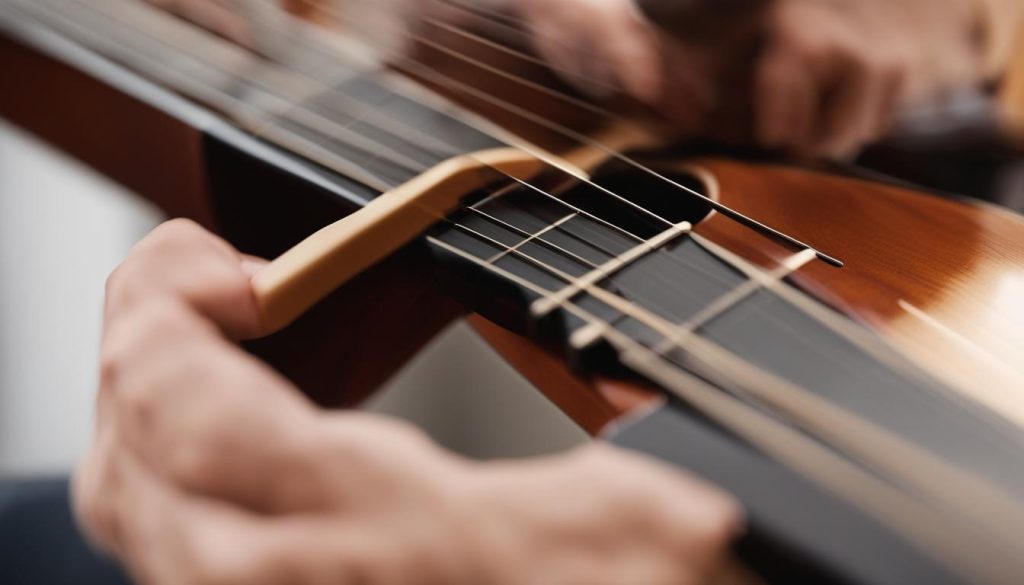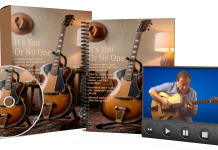This post may contain affiliate links. As an Amazon associate, Google associate as well as associate for other programs, Guitar & Music Institute may earn commissions from qualifying purchases.

If you’re a beginner looking to learn how to play the guitar, you’ve come to the right place. In this article, we will provide you with all the information you need to get started with guitar lessons. From learning chords and strumming techniques to playing songs, we’ve got you covered. So let’s dive in and start strumming!
Key Takeaways:
- Explore our free and paid guitar books and downloads at https://gmiguitarshop.com/
- Master the basic strumming technique through practice and proper wrist and arm positioning.
- Experiment with different strumming patterns to enhance your rhythm and playing style.
- Focus on smooth chord transitions while strumming by using the last upstroke for positioning.
- Maintain good posture and positioning for effective and controlled strumming.
The Basics of Strumming
Strumming is an essential skill when learning to play the guitar. The first step in strumming is mastering the down strumming technique. This involves strumming the strings downwards towards the floor. It’s important to keep your arm and wrist relaxed and let gravity do the work. Once you’ve mastered the down strum, you can add in upstrokes to create a well-balanced sound. Practice strumming in time with a metronome or backing track to improve your timing.
To ensure a clear explanation, we have prepared an easy-to-follow visual guide that demonstrates the basic strumming technique:
Now that you have a solid understanding of the basic strumming technique, let’s take a closer look at how you can add rhythm to your playing by exploring different strumming patterns. Understanding these patterns will help you develop your own unique style as you progress in your guitar journey.
Adding Rhythm with Strumming Patterns
Once you’ve mastered the basic strumming technique, it’s time to take your guitar playing to the next level by adding rhythm with strumming patterns. Strumming patterns are specific combinations of downstrokes and upstrokes that create a unique rhythm and groove for your playing. By learning different strumming patterns, you’ll be able to play a wide variety of songs in different genres, from pop to rock to folk.
Here are some popular strumming patterns to get you started:
| Strumming Pattern | Description |
|---|---|
| Down, Down, Up, Up, Down, Up | A common strumming pattern used in many songs. It’s a great pattern to practice your coordination between downstrokes and upstrokes. |
| Down, Down, Down, Up | A simple strumming pattern with a repeating downstroke sequence followed by an upstroke. It works well for slower songs or ballads. |
| Down, Down, Up | A basic strumming pattern that provides a steady rhythm. It’s commonly used in folk and acoustic music. |
Remember to start slow and practice each strumming pattern with a metronome or backing track to develop your timing and accuracy. As you become more comfortable, try incorporating these patterns into songs you’re learning or even create your own variations.
Adding rhythm with strumming patterns will bring your guitar playing to life and make it more engaging for listeners. So start practicing and experiment with different patterns to discover your unique style. Before you know it, you’ll be strumming along to your favorite songs with confidence!
Check out our latest free and paid guitar books and downloads at https://gmiguitarshop.com/.
Changing Chords while Strumming
Changing chords while strumming is a fundamental skill that every guitarist needs to master. It allows you to smoothly transition between different chords, creating a seamless and flowing sound. By practicing chord changes while strumming, you’ll develop the ability to effortlessly switch between chords and keep the rhythm going.
Here are some tips to help you improve your chord transitions:
- Position your fingers: When changing chords, it’s important to lift off the old chord and position your fingers on the new chord in a smooth and seamless motion. Place your fingers in the correct position on the fretboard and make sure they are pressing down on the strings firmly enough to produce a clear sound.
- Use the last upstroke: Use the last upstroke before the chord change to lift off the old chord and position your fingers for the new chord. This allows for a seamless transition and ensures that you don’t disrupt the rhythm of your strumming.
- Practice different chord progressions: Work on changing between different chords while strumming to improve your chord transitions. Start with simple two-chord progressions and gradually progress to more complex ones. Practice slowly at first and gradually increase your speed as you become more comfortable with the finger movements.
Example Chord Transition:

| Chord | Strumming Pattern |
|---|---|
| G | DDUUDU |
| C | DDUUDD |
| D | DUUD |
Practice changing between these chords while following the strumming pattern. Start with a slow tempo and gradually increase the speed as you become more comfortable. Remember to maintain a relaxed hand position and keep your fingers close to the fretboard for efficient chord changes.
By focusing on your chord transitions and practicing regularly, you’ll soon be able to change chords effortlessly while strumming and elevate your guitar playing to the next level. Keep practicing, stay patient, and have fun exploring the endless possibilities of music!
Proper Technique for Strumming
When it comes to playing the guitar, mastering proper strumming technique is essential. By following these tips, you’ll be able to strum with fluidity and control, enhancing your overall playing experience.
Holding the Guitar Pick
Start by holding the guitar pick between your thumb and index finger. Experiment with different grips and angles to find what feels most comfortable for you. Remember, a proper grip ensures optimal control and precision when strumming.
Strumming from the Forearm
Strumming from your forearm, rather than solely relying on your wrist, allows for fluid and controlled strumming motions. This technique creates a more natural and dynamic sound. By engaging your forearm muscles, you’ll have greater control over the volume and timing of each strum.
Keeping Your Wrist Straight
It’s important to maintain a straight wrist position when strumming. Avoid bending your wrist towards the guitar, as this can restrict your range of motion and result in limited control. Keeping your wrist straight allows for a more comfortable and efficient strumming motion.
Relaxing Your Hand and Wrist
Tension in your hand and wrist can hinder your strumming technique. Relax your hand and wrist to avoid strain and allow for more fluid movements. Loosen your grip on the pick, allowing it to glide across the strings effortlessly. Relaxation is key to achieving a smooth and natural strumming style.

| Common Mistakes to Avoid | Solutions |
|---|---|
| Gripping the pick too tightly | Loosen your grip on the pick to improve flexibility and control. |
| Strumming solely from the wrist | Engage your forearm in the strumming motion for a more expressive sound. |
| Improper hand and wrist positioning | Maintain a straight wrist and relax your hand for smoother strumming. |
By mastering proper strumming technique, you’ll be able to create a rich and dynamic sound on your guitar. Remember to practice regularly and be patient with yourself as you develop your skills.
Posture and Positioning for Strumming
Good posture and positioning are crucial when it comes to strumming the guitar effectively. By maintaining the correct posture, you can optimize your playing technique and avoid unnecessary strain or discomfort. Here are some tips to help you find the ideal posture and positioning for strumming:
- Sit on a chair without armrests or on a stool: This allows for free movement of your strumming arm without any hindrance from armrests. It provides you with the flexibility and range of motion needed for comfortable strumming.
- Keep your thigh at a 90-degree angle to your torso: This position provides stability for the guitar and allows for better control while strumming. Ensure your guitar is resting squarely on your thigh without any tilting.
- Position your strumming arm: Place your strumming arm so that your elbow is in front of the guitar’s body. This positioning allows for a natural pivot motion and helps maintain a balanced strumming technique.
- Keep your wrist straight and forearm relaxed: A straight wrist enables smooth strumming, allowing for precise control over your strokes. Relax your forearm as tension can impede your strumming motion.
By following these guidelines for posture and positioning, you’ll be able to strum the guitar with ease and comfort, enhancing your overall playing experience. Remember that practicing with proper technique is essential for developing optimal strumming skills.
Common Mistakes to Avoid
When learning to strum the guitar, beginners often make common mistakes that can hinder their progress. By being aware of these mistakes and actively working to avoid them, you can accelerate your learning and improve your strumming technique.
Gripping the Pick Too Tightly
One common mistake is gripping the pick too tightly. While it’s natural to want to have a firm hold on the pick, gripping it too tightly can result in unnecessary tension in your hand and restrict your movement. To avoid this, try holding the pick with a looser grip, allowing it to move more freely when you strum. This will give you greater control and a more relaxed playing experience.
Strumming Solely from the Wrist
Another mistake is relying solely on your wrist to strum the guitar. While the wrist plays a crucial role in strumming, it’s important to utilize the full forearm for a smoother and more fluid motion. By incorporating your forearm, you’ll have better control over dynamics and achieve a more consistent strumming pattern. Practice strumming from your forearm to develop a balanced and controlled technique.
Improper Hand and Wrist Positioning
The positioning of your hand and wrist is essential for effective strumming. Improper positioning can lead to strain and potential injury. Make sure to keep your hand relaxed, avoiding excessive tension in your fingers. Position your wrist in a neutral, straight alignment with your forearm to maintain flexibility and prevent any unnecessary strain. Developing good hand and wrist positioning will contribute to a more comfortable and efficient strumming technique.
Avoiding these common mistakes will help you progress in your guitar journey and develop a solid foundation for your strumming technique. Remember to focus on maintaining a relaxed grip, utilizing your forearm in addition to your wrist, and practicing proper hand and wrist positioning. With practice and consistency, you’ll overcome these challenges and become a confident strummer.
Conclusion
Learning how to strum the guitar is an essential skill for beginners. Through our beginner guitar lessons and beginner guitar course, you have gained a solid foundation in strumming techniques. By mastering the basic strumming technique and experimenting with different strumming patterns, you have developed your own unique rhythm and style.
Remember to always focus on proper technique, posture, and positioning to ensure fluid and controlled strumming. By practicing chord changes and honing your skills, you will soon be strumming your favorite songs with confidence and ease.
Don’t forget to check out our latest free and paid guitar books and downloads at https://gmiguitarshop.com/. With the right resources and your dedication, you will continue to improve and expand your guitar playing abilities. So grab your guitar, keep practicing, and enjoy the journey of becoming a proficient guitarist!
FAQ
What is the first step in strumming?
The first step in strumming is mastering the down strumming technique. This involves strumming the strings downwards towards the floor. Keep your arm and wrist relaxed and let gravity do the work.
How can I improve my strumming timing?
Practice strumming in time with a metronome or backing track to improve your timing. This will help you develop a steady and consistent rhythm.
What are strumming patterns?
Strumming patterns are specific combinations of downstrokes and upstrokes that create a unique rhythm. By learning different strumming patterns, you’ll be able to play a wide variety of songs in different genres.
How can I improve my chord transitions while strumming?
Practice changing between different chords while strumming to improve your chord transitions. Use the last upstroke before the chord change to lift off the old chord and position your fingers for the new chord.
What is the proper technique for strumming?
Start by holding the guitar pick between your thumb and index finger. Strum from your forearm, not just your wrist, to create fluid and controlled strumming motions. Keep your wrist straight and avoid bending it towards the guitar.
What is the correct posture for strumming?
Sit on a chair without armrests or on a stool that allows for free movement of your strumming arm. Keep your thigh at a 90-degree angle to your torso and position your strumming arm so that your elbow is in front of the guitar’s body.
What are some common mistakes to avoid when strumming?
One common mistake is gripping the pick too tightly, which can result in tension and restricted movement. Another mistake is strumming solely from the wrist instead of utilizing the full forearm, which can lead to limited control. It’s also important to maintain proper hand and wrist positioning to avoid strain and injury.
Source Links
- https://www.guitarlessonsforbeginners.com/strum-the-guitar.htm
- https://www.fretjam.com/beginner-guitar-strumming.html
- https://nationalguitaracademy.com/how-to-strum-a-guitar/
This post may contain affiliate links. As an Amazon associate, Google associate as well as associate for other programs, Guitar & Music Institute may earn commissions from qualifying purchases.























![5 Best Guitar Display Cases [2024 Reviews] lbow](https://www.guitarandmusicinstitute.com/wp-content/uploads/2024/03/lbow-100x70.jpg)


